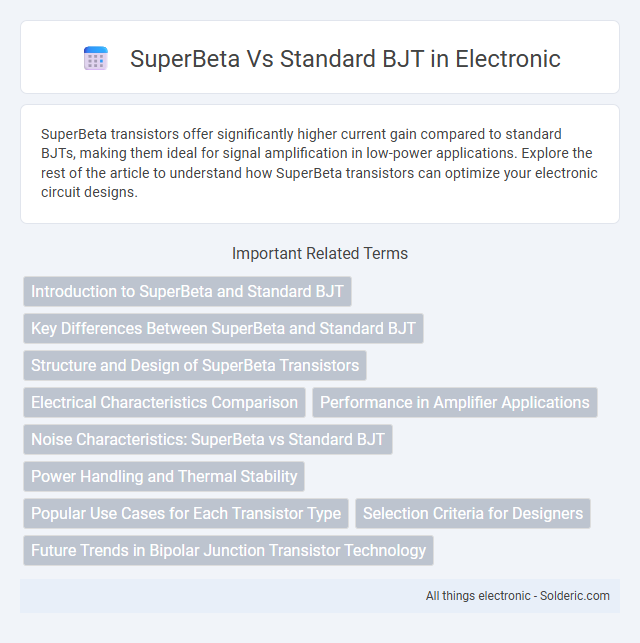SuperBeta transistors offer significantly higher current gain compared to standard BJTs, making them ideal for signal amplification in low-power applications. Explore the rest of the article to understand how SuperBeta transistors can optimize your electronic circuit designs.
Comparison Table
| Feature | SuperBeta BJT | Standard BJT |
|---|---|---|
| Current Gain (b) | High (Typically 300 to 1000) | Moderate (Typically 100 to 300) |
| Application | Low-noise, high-gain amplification | General-purpose switching and amplification |
| Frequency Response | Lower cutoff frequency | Higher cutoff frequency |
| Noise Performance | Low noise figure | Standard noise figure |
| Cost | Higher due to specialized processing | Lower, widely available |
| Saturation Voltage (VCE(sat)) | Typically higher | Typically lower |
| Temperature Stability | Moderate | Good |
Introduction to SuperBeta and Standard BJT
SuperBeta transistors exhibit higher current gain (beta) compared to Standard Bipolar Junction Transistors (BJTs), enabling improved amplification efficiency in electronic circuits. Standard BJTs consist of three layers--emitter, base, and collector--with moderate gain values suitable for general-purpose applications. SuperBeta devices use advanced semiconductor doping techniques to enhance gain, reducing the base current and increasing overall performance in high-frequency and low-noise applications.
Key Differences Between SuperBeta and Standard BJT
SuperBeta BJTs feature significantly higher current gain (beta) compared to standard BJTs, enabling improved amplification with lower base current requirements. The optimized doping profiles and thinner base regions in SuperBeta transistors reduce recombination, enhancing frequency response and overall efficiency. Standard BJTs, while more common and cost-effective, typically offer lower gain and slower switching speeds, limiting their performance in high-frequency or precision applications.
Structure and Design of SuperBeta Transistors
SuperBeta transistors feature an innovative design where multiple transistor cells are connected in parallel within a single package, significantly increasing the current gain compared to standard BJTs. Their structure often includes optimized base regions and enhanced doping profiles that minimize base resistance and maximize charge carrier injection efficiency. Your applications benefit from reduced noise and improved gain stability due to this advanced multi-finger layout, which distinguishes SuperBeta transistors from conventional single-cell BJTs.
Electrical Characteristics Comparison
SuperBeta BJTs exhibit significantly higher current gain (hFE) compared to standard BJTs, often exceeding values of 300, which enhances amplification efficiency in low-current applications. Their input impedance is generally higher, resulting in reduced base current requirements and improved signal integrity in sensitive circuits. Standard BJTs typically demonstrate faster switching speeds but lower gain, making SuperBeta transistors preferable for analog amplification where low noise and high gain are critical.
Performance in Amplifier Applications
SuperBeta BJTs offer significantly higher current gain (hFE) compared to Standard BJTs, which enhances amplifier performance by reducing the base current and power consumption. This results in improved signal amplification with lower distortion and better linearity, making SuperBeta transistors ideal for high-gain, low-noise amplifier circuits. Your amplifier design benefits from superior efficiency and increased input impedance when using SuperBeta devices over conventional BJTs.
Noise Characteristics: SuperBeta vs Standard BJT
SuperBeta transistors exhibit significantly lower noise levels compared to standard BJTs, making them ideal for high-frequency and low-signal applications. Their enhanced gain characteristics reduce thermal and shot noise, which improves signal integrity in sensitive circuits. When optimizing your design for minimal noise, selecting SuperBeta devices can enhance overall performance in audio and RF amplification systems.
Power Handling and Thermal Stability
SuperBeta transistors exhibit enhanced power handling capabilities due to their higher current gain (hFE), which reduces the base current and thus lowers power dissipation in the driving circuitry. Their improved thermal stability stems from superior semiconductor materials and design techniques that minimize leakage currents and maintain consistent gain across temperature variations. This combination allows SuperBeta BJTs to operate efficiently under higher power loads with reduced risk of thermal runaway compared to standard BJTs.
Popular Use Cases for Each Transistor Type
SuperBeta transistors are favored in high-gain amplifier circuits, where their elevated current gain enhances signal amplification in audio and RF applications. Standard BJTs are widely used in switching applications and general-purpose amplification, offering reliable performance in power regulation and digital logic circuits. Selecting Your transistor depends on whether you prioritize gain for sensitive signal processing or robust, efficient switching operations.
Selection Criteria for Designers
SuperBeta transistors offer higher current gain (hFE) compared to Standard BJTs, making them ideal for low-current applications where amplification precision is critical. Designers select SuperBeta devices to reduce base drive current and improve switching efficiency in amplifier circuits and low-power devices. Your decision should consider trade-offs like increased cost and slower switching speed associated with SuperBeta transistors.
Future Trends in Bipolar Junction Transistor Technology
SuperBeta transistors exhibit higher current gain (b) than Standard BJTs, enabling improved amplification efficiency and lower power consumption, which aligns with future trends emphasizing energy-efficient semiconductor devices. Advances in material science and fabrication techniques are expected to further enhance SuperBeta transistor performance, facilitating their integration into high-frequency and low-noise applications emerging in 5G and AI hardware. Research on scaling down device geometries while maintaining reliability is crucial for both SuperBeta and Standard BJTs to meet the increasing demands for compact, high-performance electronic components in next-generation circuits.
SuperBeta vs Standard BJT Infographic

 solderic.com
solderic.com